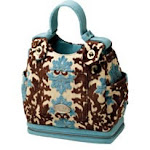My husband and I took a little "babymoon" recently to Palm Springs. We
are expecting baby #3 (a girl this time!) in June. We unknowingly
stumbled upon the last few days of Modernism Week. Normally, a visit to
Palm Springs vaguely recalls the sort of dusty, forgotten replicas of
the sleek, cocktail lounge, jet set days of yesteryear's Rat Pack. It is
so easy to pass one funky roadside hotel, gas station or stylized retro
Denny's after another without even thinking, (especially in
California)... but because it happened to be Modernism Week and it was
cold and rainy, we gathered up the event pamphlets, mapped out the hot
spots and got into it.... uncovering the truly authentic and dynamic architectural
gems of the mid-century that rest exclusively in Palm Springs. It was
a ball! I thought I'd share with my Designing Moms...
Just for reference: Modernism Week, the only event like it in the
country, is a 9-day celebration of mid-century modern design, architecture and culture. Palm
Springs is a virtual architectural museum of this style with the world's
largest and best-preserved examples of celebrated homes and landmark
buildings constructed during the 1940s, 1950s, and 1960s. This design
aesthetic was typified by clean, simple lines and elegant informality
which came to define "Desert Modernism". Desert Modernism was a
mid-twentieth century approach to modernism that capitalized on the
sunny skies and warm climate of Southern California and the American
Southwest. Desert Modernism was a regional approach to the
"International Style" architecture. Rocks, trees, and other landscape
features were often incorporated into the design. The most common
characteristics of Desert Modernism are expansive glass walls and
windows, dramatic rooflines, and wide overhangs, steel and plastic
combined with wood and stone, open floor plans, and outdoor living
spaces.
Here are some of cool, original spots that I was able to photograph and
composite on
our visit...
Palm Springs City Hall (1952-57)
Designed by Albert Frey

Kaufmann House (1946-47)
Designed by Richard Neutra

Tramway Gas Station ((1963-65)
Designed by Albert Frey

Del Marcos Hotel (1947)
Designed by William F. Cody

Bank of America (1959)
Design inspired by Le Corbusier

This style of architecture lent itself to much experimentation and
exploration in not only furniture, product and automobile design, but to
typography as well. In aiming
to define the new mid century modern style, both calligraphy and
ornamentation was widely rejected in favor of purity and elemental form.
Refined sans serif forms and grid-based, modular, and often unicase
alphabets were embraced resulting in what became known as the ubiquitous
style of Geometric Modernist type seen everywhere these days in
universal signage, branding, advertising, logos, etc. The overall look
and feel of the lettering is open, unobtrusive, simple, rational,
tightly structured, clear, harmonious. Some of these typefaces include
Futura (Paul Renner, 1927)
 Serifa (Adrian Frutiger 1967),
Serifa (Adrian Frutiger 1967),Neutra,
(Richard Neutra/Christian Schwartz 1950)
 Gill Sans (Eric Gill
Gill Sans (Eric Gill1928)

Helvetica (Max Miedinger 1957)

Univers (Adrian Frutiger
1957), Palatino
(Hermann Zapf 1948), Optima (Hermann Zaph 1952)

Universal
(Herbert
Bayer 1932) and Avant Garde (Herb Lubalin 1970).
It was a great unexpected adventure to look at Palm Springs this way,
having my inner designer awakened when I least expected it.





















3 comments:
Did you happen to stay at Del Marcos Hotel? I've designed this logo when I was working for Celery Design a few years ago.
Thank you for sharing your "babymoon" trip, and congratulations for your baby girl!!
Hi Aya, no we didn't stay there, but did tour the hotel and IT WAS FABULOUS! I'd love to stay there one time. Great work on the logo... what a fun job that must have been! All the best, Erika
these arts can also be called contemporary artworks or just a Personalized Pens Sketches
Post a Comment